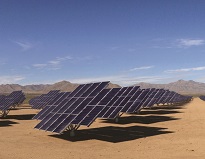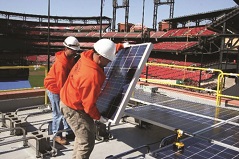

According to GTM Research and the Solar Energy Industries Association (SEIA), the U.S. installed seven gigawatts (GW) of solar last year – a whopping 42 percent increase over 2013 – making it the best year ever for solar installations in America. What’s more, solar accounted for a record 32 percent of all new electric generation capacity installed in 2014, pushing solar to the front as the fastest-growing source of renewable energy in America.
At the beginning of 2015, the U.S. has 20 GW of installed solar capacity, enough to effectively power nearly four million homes in the United States – or every single home in a state the size of Massachusetts or New Jersey – with another 20 GW in the pipeline for 2015-16.
In addition, innovative solar heating and cooling systems (SHC) are offering American consumers cost-efficient, effective options for meeting their energy needs, while lowering their utility bills. In fact, a report prepared for SEIA outlines an aggressive plan to install 100 million SHC panels in the United States by 2050. This action alone would create 50,250 new American jobs and save more than $61 billion in future energy costs.
Helping to Protect the Environment
From an environmental perspective, solar helped to offset 22.3 million metric tons of harmful CO2 emissions in 2014, which is the equivalent of taking nearly five million cars off U.S. highways, saving 2.5 billion gallons of gasoline or shuttering six coal-fired power plants.
Simply put, when looking at America’s energy future, solar can be a real game changer, providing more and more homes, businesses, schools and government entities across the U.S. with clean, reliable and affordable electricity, while also helping states to meet proposed new obligations under Section 111(d) of the Clean Air Act.
Today, the U.S. solar market segments include utility-scale photovoltaic or PV (48 percent); utility-scale concentrating solar power, also known as CSP (9 percent); non-residential PV (26 percent); and residential PV (17 percent). All totaled, there are an estimated 650,000 installed solar energy systems in the U.S., including systems on more than half a million homes.

U.S. businesses are also investing heavily in solar. According to SEIA’s annual Solar Means Business report, which identifies major commercial solar projects and ranks top corporate solar users, Walmart remained America’s commercial solar leader for the third year in a row with 105 megawatts (MW) installed at 255 locations.
Other blue chip companies with large solar portfolios include Costco, Kohl’s, Apple, IKEA, Macy’s, Johnson & Johnson, McGraw Hill, Staples, Campbell’s, U.S. Foods, Bed Bath & Beyond, Kaiser Permanente, Volkswagen, Walgreens, Target, Safeway, FedEx, Intel, L’Oreal, General Motors, Toys “R” Us, Verizon, Toyota and AT&T.
Combined, these companies have deployed 569 MW of solar capacity – a 28 percent increase over a year ago. Collectively, they’re playing an increasingly important role in the development, expansion and promotion of solar nationwide, while also reducing their operating expenses, benefiting customers and shareholders alike.
Utility-Scale Solar Continues Impressive Growth
But the growth of solar in the United States isn’t limited to commercial businesses – it’s spread across all sectors. Today, there are nearly 15 GW of utility-scale, clean energy solar projects under contract in the U.S. – utilizing both PV and CSP technologies – which will put thousands of electricians, steelworkers and laborers to work, spurring the economy while helping to reduce carbon emissions.
Additionally, more than 15 major solar power plants (100 MW and above) have already come online, including Ivanpah (392 MW), Topaz (300 MW), Agua Caliente (290 MW), Solana (280 MW) and Desert Sunlight (278 MW). Solana also features six hours of thermal energy storage, enabling it to deliver electricity long after the sun has gone down.
America’s K-12 Schools Embracing Solar
Schools are investing heavily in solar, too. According to a new, first-of-its-kind study, America’s K-12 schools have shown explosive growth in their use of solar energy over the last decade, soaring from 303 kilowatts (kW) of installed capacity to 457,000 kW, while reducing carbon emissions by 442,799 metric tons annually.

The report is the first nationwide assessment of how solar energy helps to power schools in communities across America. Most important, the report shows that thousands of schools are already cutting their utility bills by choosing solar, using the savings to pay for teacher salaries and textbooks.
Here are the report’s key findings:
-
There are 3,752 K-12 schools in the U.S. with solar installations, benefiting nearly three million students.
-
Today, America’s K-12 schools have a combined capacity of 490 MW, generating 642,000 megawatt-hours (MWh) of electricity each year.
-
Of the 125,000 schools in the country, as many as 72,000 could “go solar” cost-effectively.
Additionally, an analysis performed for the report found that 450 individual school districts could each save more than $1 million over 30 years by installing a solar PV system. New York City, alone, could save $209 million. In a time of tight budgets and rising costs, solar can be the difference between hiring new teachers – or laying them off.
Effective Public Policies Paying Dividends
What’s spurring this rapid growth? For one thing, solar energy is now more affordable than ever. According to SEIA/GTM Research, national blended average system prices have dropped 53 percent since 2010.
Today, the solar industry employs 174,000 Americans and pumps nearly $18 billion a year into the U.S. economy. This remarkable growth is due, in large part, to smart and effective public policies, such as the solar Investment Tax Credit (ITC), Net Energy Metering (NEM) and Renewable Energy Standards (RES). By any measurement, these policies are paying huge dividends for both the economy and environment. Here’s how they work:
Solar Investment Tax Credit (ITC):
The solar ITC is a 30 percent tax credit for solar systems on residential (under Section 25D) and commercial (under Section 48) properties. As a stable, multi-year incentive, the ITC encourages private sector investment in solar manufacturing and solar project construction. As such, the solar ITC is the cornerstone of continued growth of solar energy in the United States. Under current law, the ITC will remain in effect through Dec. 31, 2016.
The ITC has fueled dramatic growth in solar installations. The market certainty provided by a multiple-year extension of the residential and commercial solar ITC has helped annual solar installations grow by more than 70-fold, rocketing from 106 MW to 7,400 MW, since the ITC was implemented in 2006 – a compound annual growth rate of 53 percent.
Renewable Energy Standards (RES):
An RES requires utility companies to source a certain amount of the energy they generate or sell from renewable sources such as wind and solar, while also establishing incremental targets which increase over time, helping to reduce pollution and fight climate change. They are sometimes called renewable portfolio standards (RPS). These standards have proven to be one of the most effective policy mechanisms for driving demand of solar and other renewables. Currently, 29 states, plus the District of Columbia, have effective RPS policies.
The importance of establishing and maintaining effective public policies was highlighted in two reports issued last year by the International Energy Agency (IEA), which predicted solar could be the world’s largest source of electricity by 2050 – so long as policymakers provide “clear, credible and consistent signals.” As an industry, we couldn’t agree more.

